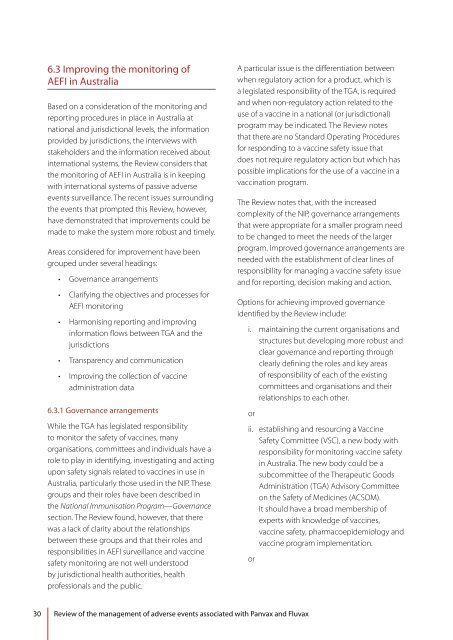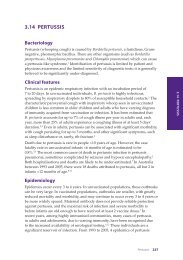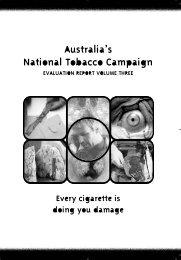Review of the management of adverse effects associated with ...
Review of the management of adverse effects associated with ...
Review of the management of adverse effects associated with ...
Create successful ePaper yourself
Turn your PDF publications into a flip-book with our unique Google optimized e-Paper software.
6.3 Improving <strong>the</strong> monitoring <strong>of</strong><br />
AEFI in Australia<br />
Based on a consideration <strong>of</strong> <strong>the</strong> monitoring and<br />
reporting procedures in place in Australia at<br />
national and jurisdictional levels, <strong>the</strong> information<br />
provided by jurisdictions, <strong>the</strong> interviews <strong>with</strong><br />
stakeholders and <strong>the</strong> information received about<br />
international systems, <strong>the</strong> <strong>Review</strong> considers that<br />
<strong>the</strong> monitoring <strong>of</strong> AEFI in Australia is in keeping<br />
<strong>with</strong> international systems <strong>of</strong> passive <strong>adverse</strong><br />
events surveillance. The recent issues surrounding<br />
<strong>the</strong> events that prompted this <strong>Review</strong>, however,<br />
have demonstrated that improvements could be<br />
made to make <strong>the</strong> system more robust and timely.<br />
Areas considered for improvement have been<br />
grouped under several headings:<br />
• Governance arrangements<br />
• Clarifying <strong>the</strong> objectives and processes for<br />
AEFI monitoring<br />
• Harmonising reporting and improving<br />
information flows between TGA and <strong>the</strong><br />
jurisdictions<br />
• Transparency and communication<br />
• Improving <strong>the</strong> collection <strong>of</strong> vaccine<br />
administration data<br />
6.3.1 Governance arrangements<br />
While <strong>the</strong> TGA has legislated responsibility<br />
to monitor <strong>the</strong> safety <strong>of</strong> vaccines, many<br />
organisations, committees and individuals have a<br />
role to play in identifying, investigating and acting<br />
upon safety signals related to vaccines in use in<br />
Australia, particularly those used in <strong>the</strong> NIP. These<br />
groups and <strong>the</strong>ir roles have been described in<br />
<strong>the</strong> National Immunisation Program—Governance<br />
section. The <strong>Review</strong> found, however, that <strong>the</strong>re<br />
was a lack <strong>of</strong> clarity about <strong>the</strong> relationships<br />
between <strong>the</strong>se groups and that <strong>the</strong>ir roles and<br />
responsibilities in AEFI surveillance and vaccine<br />
safety monitoring are not well understood<br />
by jurisdictional health authorities, health<br />
pr<strong>of</strong>essionals and <strong>the</strong> public.<br />
A particular issue is <strong>the</strong> differentiation between<br />
when regulatory action for a product, which is<br />
a legislated responsibility <strong>of</strong> <strong>the</strong> TGA, is required<br />
and when non-regulatory action related to <strong>the</strong><br />
use <strong>of</strong> a vaccine in a national (or jurisdictional)<br />
program may be indicated. The <strong>Review</strong> notes<br />
that <strong>the</strong>re are no Standard Operating Procedures<br />
for responding to a vaccine safety issue that<br />
does not require regulatory action but which has<br />
possible implications for <strong>the</strong> use <strong>of</strong> a vaccine in a<br />
vaccination program.<br />
The <strong>Review</strong> notes that, <strong>with</strong> <strong>the</strong> increased<br />
complexity <strong>of</strong> <strong>the</strong> NIP, governance arrangements<br />
that were appropriate for a smaller program need<br />
to be changed to meet <strong>the</strong> needs <strong>of</strong> <strong>the</strong> larger<br />
program. Improved governance arrangements are<br />
needed <strong>with</strong> <strong>the</strong> establishment <strong>of</strong> clear lines <strong>of</strong><br />
responsibility for managing a vaccine safety issue<br />
and for reporting, decision making and action.<br />
Options for achieving improved governance<br />
identified by <strong>the</strong> <strong>Review</strong> include:<br />
i. maintaining <strong>the</strong> current organisations and<br />
structures but developing more robust and<br />
clear governance and reporting through<br />
clearly defining <strong>the</strong> roles and key areas<br />
<strong>of</strong> responsibility <strong>of</strong> each <strong>of</strong> <strong>the</strong> existing<br />
committees and organisations and <strong>the</strong>ir<br />
relationships to each o<strong>the</strong>r.<br />
or<br />
ii. establishing and resourcing a Vaccine<br />
Safety Committee (VSC), a new body <strong>with</strong><br />
responsibility for monitoring vaccine safety<br />
in Australia. The new body could be a<br />
subcommittee <strong>of</strong> <strong>the</strong> Therapeutic Goods<br />
Administration (TGA) Advisory Committee<br />
on <strong>the</strong> Safety <strong>of</strong> Medicines (ACSOM).<br />
It should have a broad membership <strong>of</strong><br />
experts <strong>with</strong> knowledge <strong>of</strong> vaccines,<br />
vaccine safety, pharmacoepidemiology and<br />
vaccine program implementation.<br />
or<br />
30<br />
<strong>Review</strong> <strong>of</strong> <strong>the</strong> <strong>management</strong> <strong>of</strong> <strong>adverse</strong> events <strong>associated</strong> <strong>with</strong> Panvax and Fluvax







